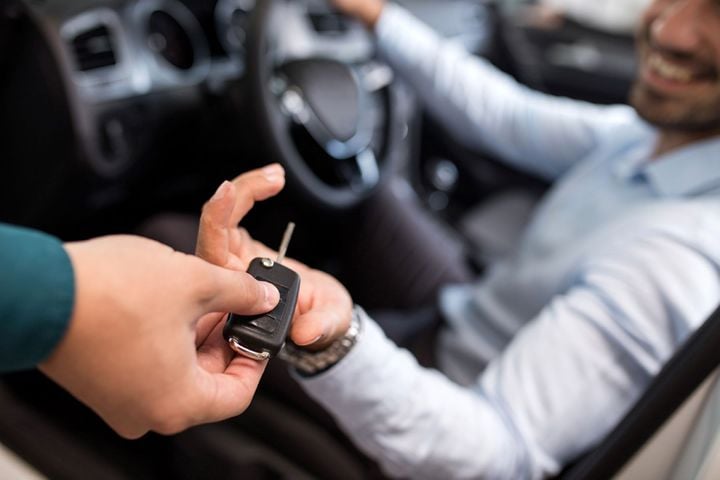
New research from Cox Automotive shows consumer satisfaction with the car buying process declined in 2022 for the second consecutive year.
IMAGE: Getty Images
New research from Cox Automotive shows consumer satisfaction with the car buying process declined in 2022 for the second consecutive year.
The 2022 Car Buyer Journey Study reveals high prices, limited availability, and the time required to complete the process frustrated car buyers. Used-vehicle buyers, who are often more price sensitive and face higher interest rates, were most unsatisfied with the experience in 2022, Cox found.
Cox Automotive’s annual Car Buyer Journey Study has offered a comprehensive look at the overall vehicle buying process in the United States since 2009. The annual study provides a holistic peek at the car buying journey from research to purchase.
“With the annual NADA convention opening in Dallas later this month and bringing together auto dealers from across the country, we think it is more important than ever to showcase the current state of vehicle buying in America,” said Isabelle Helms, vice president of Research and Market Intelligence at Cox Automotive in a press release. “While buying a vehicle is a complicated transaction, with financing required, trade-in valuations to consider and plenty of research required, it does not have to be frustrating for the consumer. With the right digital tools and systems in place, car buying can be a highly satisfying activity, and as efficient and streamlined as consumers want it to be.”
Cox surveyed over 10,000 consumers in the market for a vehicle in 2022. This included 4,150 vehicle shoppers and 6,118 vehicle buyers. The research analysts also surveyed dealers. Most of research occurred during the second half of 2022.
Cox listed some key takeaways from the 2022 Cox Automotive Car Buyer Journey Study
- Overall satisfaction with the car buying journey declined in 2022. Cox reports 61% of vehicle buyers in 2022 were highly satisfied with the process, down from 66% in 2021, and well below the peak of 72% in 2020. Satisfaction for new-vehicle buyers declined modestly to 70%, down from 71% in 2021, while satisfaction among used-vehicle buyers fell significantly. In 2021, 65% of used-vehicle buyers noted they were highly satisfied with the process. In 2022, the percentage dropped to 58%.
- Time spent. Consumers named the top reason for their dissatisfaction as time spent on the purchase process, which jumped in 2022. The average vehicle buyer reported the process took 14 hours and 39 minutes, up from 12 hours and 27 minutes in 2021, an increase of 18%. Time spent online shopping and researching vehicles increased by over 1 hour compared to 2021, while time at the dealership increased by around 20 minutes.
- Research increased. Vehicle shoppers visited an average of 4.9 sites, up from 4.0 in 2021. Cox found third-party sites played the largest role, with 79% of buyers visiting sites such as Kelley Blue Book or Autotrader, both Cox Automotive sites, during the process, followed by dealership sites (59%), used vehicle online retailers such as Carvana and Vroom (34%), and automaker websites (33%). Also, around 13% of buyers used a lender website when shopping for their most recent vehicle purchase, an 86% increase from 2021.
- Limited inventory. In 2022, the shopping experience became less about finding the “perfect” vehicle and more about finding any vehicle, reports Cox. Over half of the vehicle buyers in 2022 who reported limited inventory, said limited inventory drove the increased time spent researching and shopping online.
- Less loyal. Buyers also showed less loyalty to dealerships and vehicle brands last year, especially new-vehicle buyers. In 2022, 37% of new-vehicle buyers purchased a brand they had never owned before, up from 31% in 2021. A record share of shoppers also considered both new and used vehicles last year: 64%, up from 55% in 2021.
- Record prices. Buyers reported being negatively impacted by soaring vehicle prices. In 2022, 54% of buyers found prices to be higher than expected, compared to 31% in 2021. And 63% of buyers reported paying more than they intended for a vehicle, compared to 48% in 2021. Among all buyers, satisfaction with the price paid declined from 63% in 2021 to 40% in 2022.
- Vehicle ordering increased significantly in 2022. Cox reports one in five new vehicle sales last year was a pre-ordered vehicle, an 89% increase year over year. Consumers (79%) who ordered vehicles reported being more satisfied with the experience, compared to a previous experience of buying off the lot.
- More buyers selected F&I products with their purchases in 2022 and leaned into lenders they trust. In 2022, 67% of vehicle buyers purchased an F&I product, up from 59% in 2021. Consumers purchased an average of 1.6 products, an increase from 1.3 products in 2021. Shoppers chose products such as extended warranties, GAP insurance, and tire and wheel products to protect their investment. They also selected a lender based on the interest rate.
- Digital solutions make the car buying journey better. Cox reported nearly 87% of auto dealers indicate that digital retailing solutions have positively impacted at least one area of their business, reducing time spent, improving efficiency, and also benefitting sales, profits, and relationships with customers. And 81% of shoppers in 2022 noted online activities improved their overall buying experience. Also, 78% of buyers believe an eCommerce approach provides greater transparency around pricing, and 86% say it allows them to interact with fewer dealership sales personnel.
Find more information about the 2022 Car Buyer Journey Study here.














